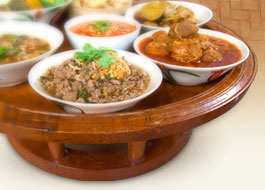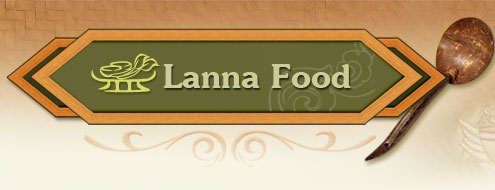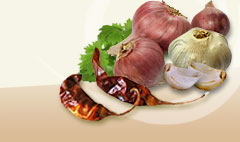Coriander |
|
|
 | Coriandrum sativum L. Ex H |
|
| |
 | Umbelliferea |
|
| |
 | Coriander |
|
| |
 | Hom pom,, phak pom (Northern) (Rattana Phromphichai, 1999, p. 7531), phak hom noi (Northeastern), phak hom (Nakhon Phanom) (Agricultural Extension Department, 2007) |
|
| |
 | Small annual shrub, 20-30 cm high with short tap root and lots of fibrous roots, erect and hollow, very fine leaves and stems. Flowers are umbrella-like, white. Seeds are round and split into 2 halves. All parts of the plant are fragrant. Another variety of it called hom pom per has bigger leaves and stems but a very mild aroma. (Rattana Phromphichai, 1999, p. 7531) |
|
| |
 |

No nutritional information available. All parts of it can be used to enhance the flavor and aroma of food and to decorate food, also. Seeds are used especially in chili paste for lap. |

Aids in passing gas, relieving stuffy stomach, fresh stems are crushed and put on the temple to relieve a headache or used to relieve skin rash or boils, to bath with when one gets the measles or mumps. Seeds are boiled and drunk to stop stomachache or to rinse the mouth out with to reduce toothache. Lanna medicine texts mention its being used in medicine for boils and goiter. (Rattana Phromphichai, 1999, p. 7531) |
|
| |
 | All year round |
|
| |
 |
Agricultural Extension Department. Phak chi Retrieved 12 July 2007 from http://www.doae.go.th/Library/html/detail/pukchee/index.htm. (in thai).Rattana Phromphichai. (1999). Hompom. InSaranukrom Wattanathamthai Phak Nuea (Vol.14,p.7531). Bangkok: The Siam Commercial Bank Foundation for the Encyclopedia of Thai Culture.(in thai). |
|
| |
|
|




